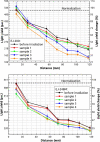Proton irradiation of plastic scintillator bars for POLAR-2
- PMID: 38145002
- PMCID: PMC10746763
- DOI: 10.1007/s10686-023-09906-8
Proton irradiation of plastic scintillator bars for POLAR-2
Abstract
POLAR-2, a plastic scintillator based Compton polarimeter, is currently under development and planned for a launch to the China Space Station in 2025. It is intended to shed a new light on our understanding of Gamma-Ray Bursts by performing high precision polarization measurements of their prompt emission. The instrument will be orbiting at an average altitude of 383 km with an inclination of 42° and will be subject to background radiation from cosmic rays and solar events. In this work, we tested the performance of plastic scintillation bars, EJ-200 and EJ-248M from Eljen Technology, under space-like conditions, that were chosen as possible candidates for POLAR-2. Both scintillator types were irradiated with 58 MeV protons at several doses from 1.89 Gy(corresponding to about 13 years in space for POLAR-2) up to 18.7 Gy, that goes far beyond the expected POLAR-2 life time. Their respective properties, expressed in terms of light yield, emission and absorption spectra, and activation analysis due to proton irradiation are discussed. Scintillators activation analyses showed a dominant contribution of β + decay with a typical for this process gamma-ray energy line of 511 keV.
Keywords: Cosmic rays; POLAR-2; Plastic scintillator; Protons; Radiation.
© The Author(s) 2023.
Conflict of interest statement
Competing interestsThe authors declare no competing interests.Conflicts of interestThe authors declare that the research was conducted in the absence of any commercial or financial relationships that could be construed as a potential conflict of interest.
Figures














References
-
- Produit N, Bao TW, Batsch T, Bernasconi T, Britvich I, Cadoux F, Cernuda I, Chai JY, Dong YW, Gauvin N, Hajdas W, Kole M, Kong MN, Kramert R, Li L, Liu JT, Liu X, Marcinkowski R, Orsi S, Pohl M, Rapin D, Rybka D, Rutczynska A, Shi HL, Socha P, Sun JC, Song LM, Szabelski J, Traseira I, Xiao HL, Wang RJ, Wen X, Wu BB, Zhang L, Zhang LY, Zhang SN, Zhang YJ, Zwolinska A. Design and construction of the polar detector. Nucl. Instrum. Methods Phys. Res. Sect A Accelerators Spectrometers Detectors Assoc. Equip. 2018;877:259–268. doi: 10.1016/j.nima.2017.09.053. - DOI
-
- De Angelis, N., et al.: Development and science perspectives of the POLAR-2 instrument: a large scale GRB polarimeter. PoS ICRC2021, 580 (2021). 10.22323/1.395.0580
-
- Eljen Technology. https://eljentechnology.com/products/plastic-scintillators. Accessed May 2023
-
- Kole, M., et al.: Gamma-ray polarization results of the POLAR mission and future prospects. PoS ICRC2021, 600 (2021). 10.22323/1.395.0600
LinkOut - more resources
Full Text Sources
